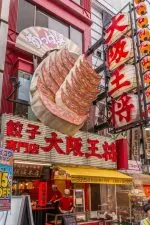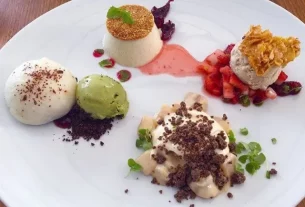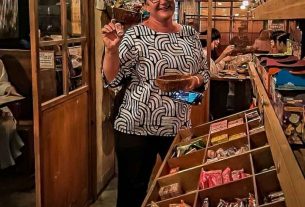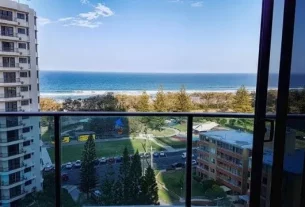
One thing we love about Osaka is the food culture here. There’s a reason the city has earned a reputation as Japan’s kitchen. While you can savour all types of food, and there are some excellent high-end restaurants to enjoy, it’s the street food culture that really makes Osaka different from other Japanese cities.
This Osaka food tour takes you through the streets of Namba, Dotonbori and Shinsekai with a local as you share the special dishes that originated on these streets.
We love this part of the city and Namba/Dotonbori is our pick of areas to stay in Osaka. It’s easy to access from Shin-Osaka if you arrive by bullet train, and from the Airport too. Many of the “must-see” attractions of the city are nearby and the food options are outstanding as you are about to see.

Although we’ve stayed in the area a number of times now and have wandered its streets by day and night there is always more to learn and savour. On this trip, we joined a Magical Trip Osaka food tour and spent the afternoon with a local guide learning more about this fascinating area, its food culture, and some of the signature dishes.
Table of Contents
Our Osaka food tour
This tour has been enhanced again in the weeks since we did it by including the nearby Shinsekai area. We were so excited to hear about this addition because Shinsekai is where one of Osaka’s best-known dishes was created, we have more on that below.
Travelling in a country where you don’t speak the language it can be an interesting challenge in choosing the right tour. You want a local guide who can provide those extra insights that really enhance your experience but at the same time, we need an English-speaking guide to understand the nuances of what is being said. We had the best of both with Miori who knows the area inside out and has studied in Australia so she speaks excellent English.
We got a lot of insight during the tour into how Osaka, and particularly the areas of Shinsekai and Dotonbori that we walked through, have developed and changed over time. In addition to learning about the dishes Miori shares how the neighbourhoods and the local community have been shaped by their history and how they have evolved over time.
At one point in Dotonbori Miori disappeared into what seems to be not much more than a crack between buildings and we follow to find ourselves in a wonderful tribute to the area’s history and a small community temple. We must have walked past here a dozen times or more and even visited the temple behind from a different direction but had never found it on our own. These are the reasons we love to explore with a local when we get the chance.
Shinsekai
The tour starts in Shinksekai, an older neighbourhood in the south of the city near Tennoji. It began in 1912 with big plans to model the development of the successful and bustling cities of Paris and New York. By 1923 the dream was over and the area fell into disrepair becoming one of the poorest in the city.
Over the decades it became known as a risky part of town with an active red-light district and many homeless people forced into living on the streets. Today it has refound its place as a popular destination for locals and tourists to stop by, wander through the narrow streets and eat some tasty food.
Kushi-katsu

From necessity came invention. Hungry workers needed to eat on tight budgets which created an increased demand for food that was both filling and cheap. One of the results was kushikatsu, also called Kushiage, which is a breaded and deep-fried skewer of meat and vegetables. It is believed to have originated right here in Shinsekai in 1929 at a casual restaurant called Daruma that is still operating today.
There are so many varieties available that you might find it hard to choose. Many locals in Osaka will have their favourite that they gravitate to for a little snack, for our guide it was quail eggs but there are so many options of protein and vegetables that it can be difficult to make your mind up. Some less familiar options like beef tendon can be remarkably tender and unexpected options like mochi, a pounded rice cake, are delicious.
A couple of things to keep in mind in a typical Kushiage shop are that (a) the sauce is incredible and will elevate everything you put in it, and (b) it comes in a communal pot on the table and you must not double-dip.
There is an easy way around the conundrum. You’ll also see a plate of broken-up cabbage leaves on the table, they are one of the things that are miraculously delicious dipped in the sauce but they serve a couple of purposes. Eating raw cabbage alongside the fried food stops it from sitting so heavily in your stomach and causing that unpleasant feeling that often comes with fried food, they also act as a scoop for some extra sauce that you can use to dip your skewer without returning it to the shared pot.
Ura-Namba
From Shinsekai the tour heads a couple of kilometres north to experience some more uniquely Osaka food creations.
To get to the river and Dotonbori area from the Namba train stations you can either walk through the narrow lanes or covered shopping arcades. The area is called Ura-Namba, literally, I’m told it means the backside of Namba.

That might not sound so flattering but where Osaka is known as Japan’s kitchen, Ura-Namba is Osaka’s kitchen. It’s only a couple of minutes’ walk from the station but this area is jam-packed with interesting izakaya, bars and restaurants.
From around 7 pm every evening this area is humming and it keeps its energy high right through until the trains start running again the next morning. It’s a popular area to explore, hip but not exclusive, and it feels quite safe to head out here in the evening for dinner.
Dotonbori

As the tour progresses we find ourselves on the Ebisu bridge over the Dotonbori river. Day or night it’s always packed here. Something you will hear frequently around Osaka from friends and colleagues is “I’ll meet you by the Glico man”.
Miori points out the Glico running man sign above the canal and has us strike a similar pose for the ubiquitous canal photo. You might expect from the billboard that Glico is the Japanese equivalent of a sports brand like Adidas but no, their most well-known product that you will no doubt come across on your travel here is Pocky. A candy treat that’s become popular around the world.

The Dotonbori area revolves around the canal and a wide parallel pedestrian street lined with still more restaurants and shops. I’m not normally a big city person or particularly fond of crowds, but there is something about the energy here that I absolutely love. It’s very different from the business and shopping heart of the city
We continued sampling the Osaka local food all through here with some fabulous casual dishes to try out.
Okonomiyaki

This is a long-time favourite of mine, I’ve even been working on perfecting my own gluten-free okonomiyaki recipe at home. To be clear, Osaka isn’t the only place in Japan where you’ll find okonomiyaki on the menu. There are various regional variations that have evolved around it but Osaka is where it started and although it is a bit controversial I do feel that Kansai okonomiyaki is the best.
The Hiroshima variant is loaded up with noodles and it’s so filling that it takes a big appetite to finish a whole one. In Tokyo their regional adaptation is called Monjayaki and is a much wetter mix, you eat it with a small spatula as it’s almost impossible with chopsticks. I find it more dominant in salty than umami flavours which I guess comes from the stock reducing as it cooks.
Takoyaki

Takoyaki is basically octopus balls. Little savoury dumplings that are crispy on the outside, soft and delicate on the inside and filled with a good chunk of octopus in the centre.
Finding somewhere you can watch them being cooked is half the fun as they transform from a runny batter in a cast iron pan into perfect little spheres with the expert twisting and flicking of the skewers.
A couple of takoyaki shops, Aizuya and Akaoni, were even mentioned in a Michelin guide a few years back for these tasty little morsels but that doesn’t mean they are necessarily the only, or best, places to try them. Make sure to test out a few stores, there are subtle differences at each one.
I’m a bit traditional on this and like my takoyaki to include Tako (octopus) but there are many other options offered now including mochi and cheese. The most familiar topping for takoyaki is Japanese-style mayonnaise and dried shaved bonito (tuna) but in Osaka mayo with a sprinkle of salt is the local preference.
Gyoza
These little pan-fried dumplings didn’t originate in Osaka, or even in Japan for that matter but they have been embraced as part of the local cuisine around here.
Also known as potstickers or jiaozi in China they are traditionally filled with pork, green onions and other flavours wrapped in a thin wrapper and then cooked by a combination of frying and steam. Like Takoyaki you will find many different variations are now on offer with most stands having their specialty offerings.
We try them on the tour with two equally good condiments and it’s hard to pick between them although they are very different. One sauce is LaYu which is a Japanese chilli oil often served with both ramen and gyoza, and the other is a creamy sesame sauce, almost like a very smooth peanut sauce.

Final thoughts on our Osaka food tour
This city really is all they say it is when it comes to Japanese cuisine. Whether you are spending up on high-end restaurants with world-renowned chefs or snacking at Michelin-recommended street food vendors they have it all here.
The people’s food, okonomiyaki, takoyaki and kushikatsu might be inexpensive but they have stood the test of time for a reason and when you find the best places to eat them they can be really delicious.
If you do love Japanese food and some of the unique local ingredients don’t miss out on a stop at Kuromon Market nearby. We never go to Osaka without a breakfast stop here and mix it up with tasting from the various stalls. Follow the link to find our top recommendations.
You’ll find the tour information, dates and times here if you are considering joining the local Osaka food tour yourself.
Tips for travel in Tokyo
✈ For all the essential tips to help plan your visit to Japan see our comprehensive and FREE Japan guide.
✈ Free WIFI isn’t widely available in Japan. For translation, directions, timetables and other information on the go personal WIFI is one of our essentials. We look at the options in our cheat sheet to staying connected in Japan. We use WIFI2Go from Australia (mention us for a discount) or airport collection in Japan.
✈ You don’t need it if you are only visiting Tokyo but if you’re travelling distance by train the JR Passes can be a bargain. See if they suit your trip and check prices with our preferred supplier.
✈ Looking for a great place to stay in Osaka? We use and trust Booking.com for its great selection, independent reviews and cancellation options if your plans need to change.
Interested? Save it to Pinterest



